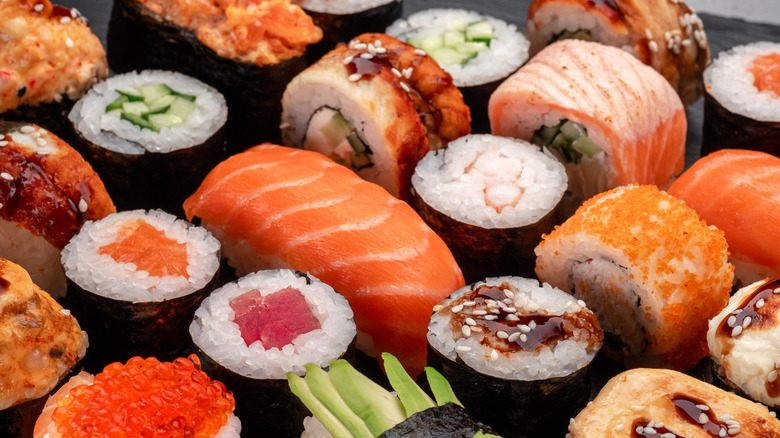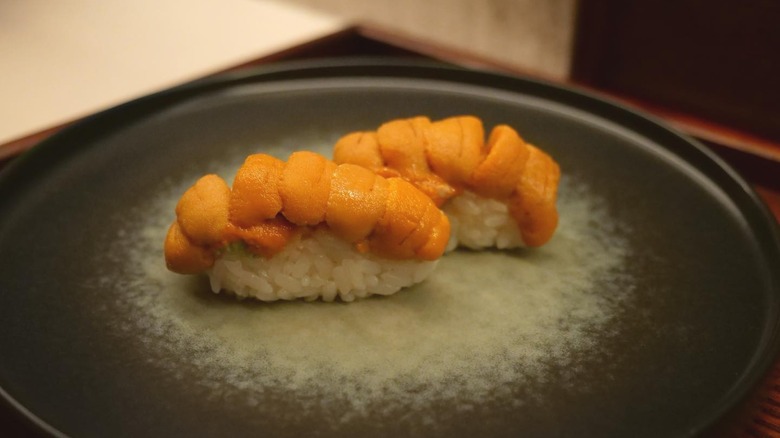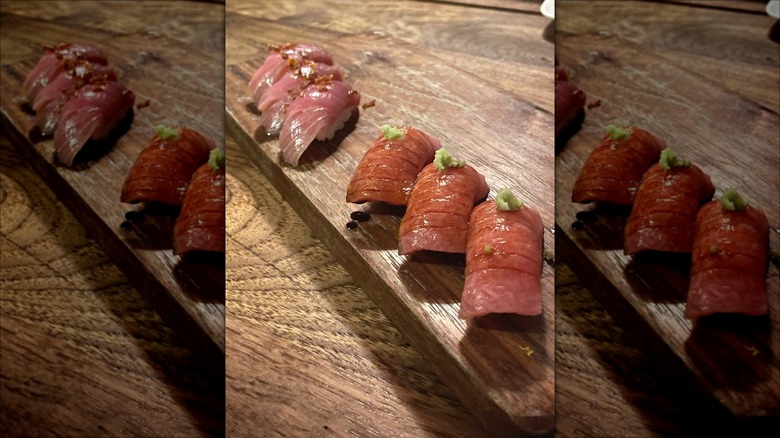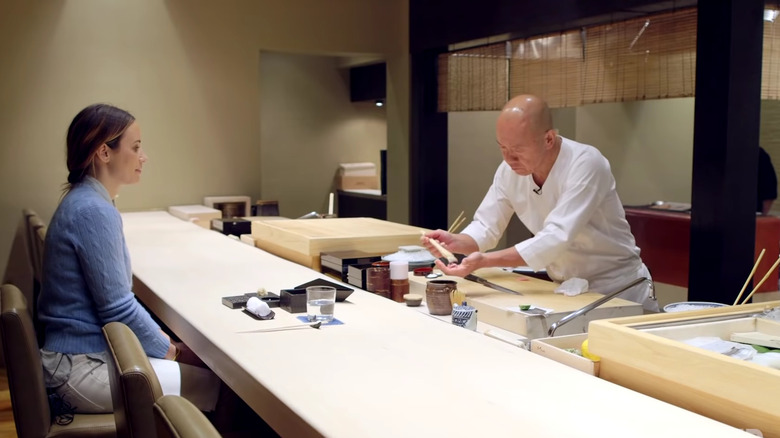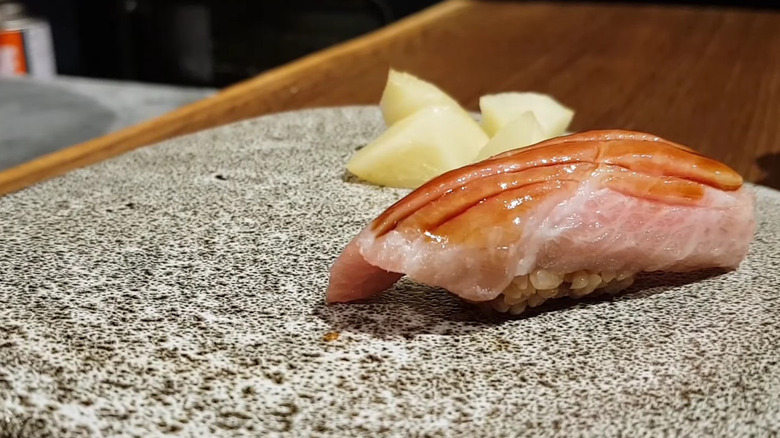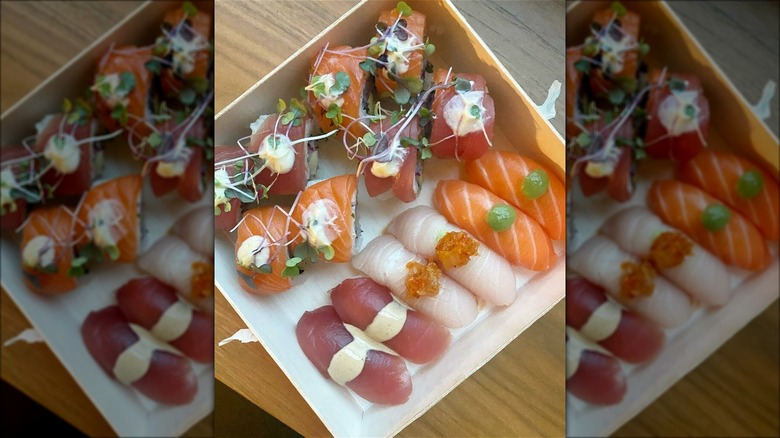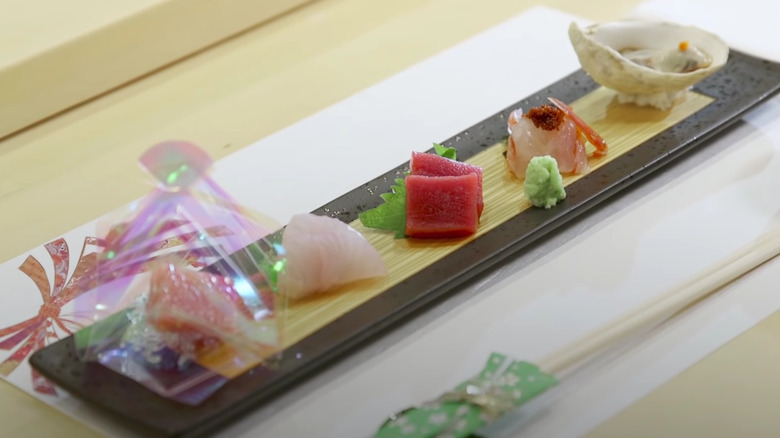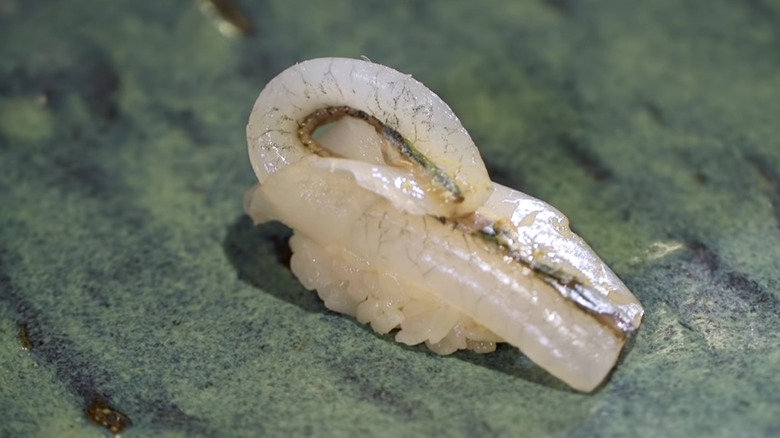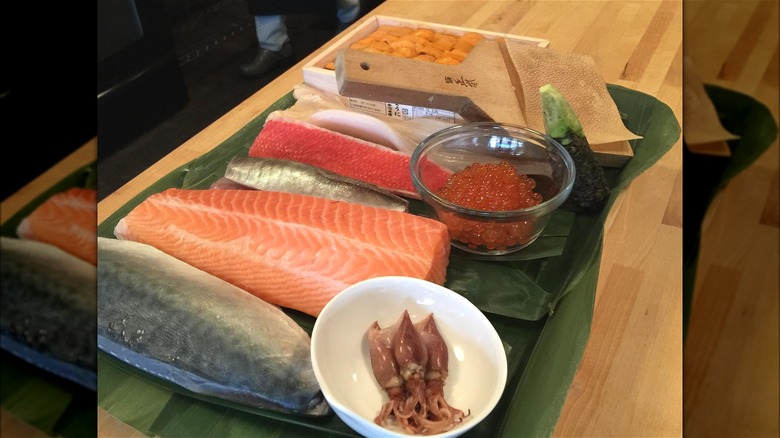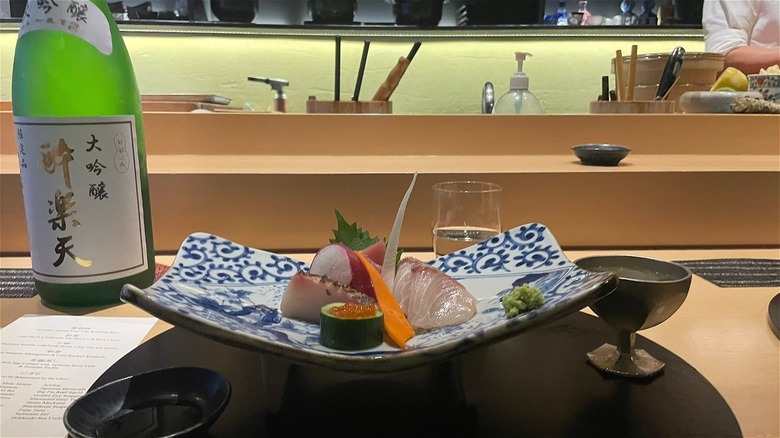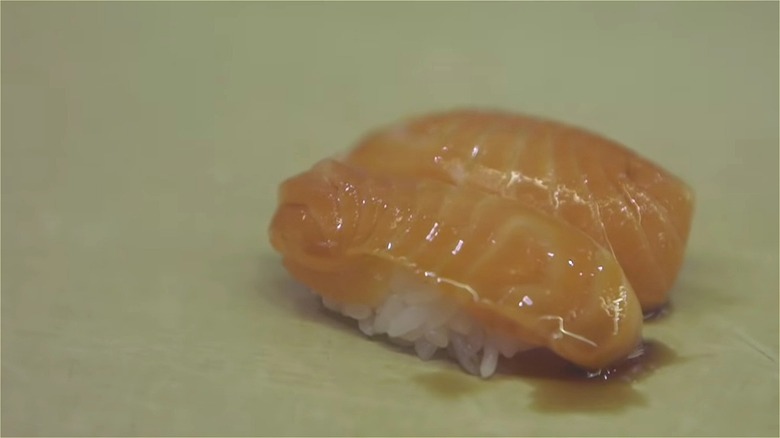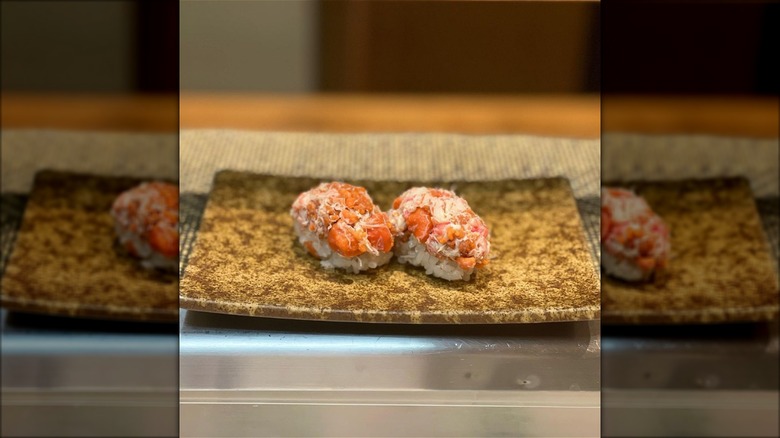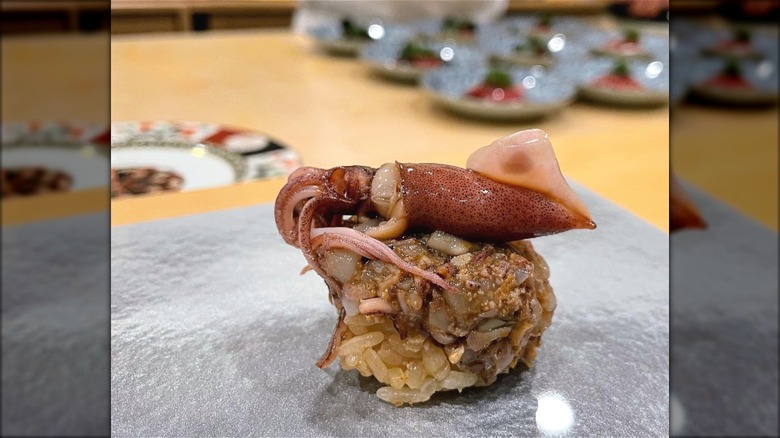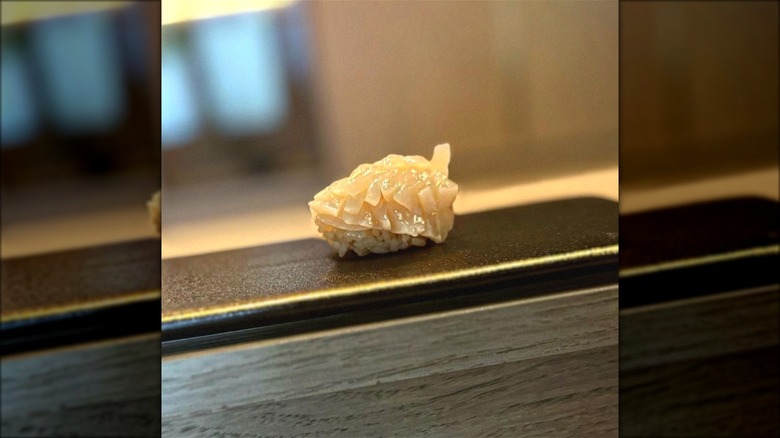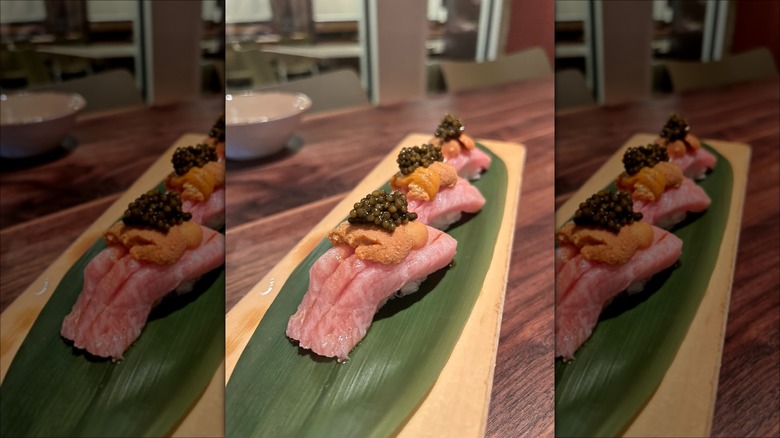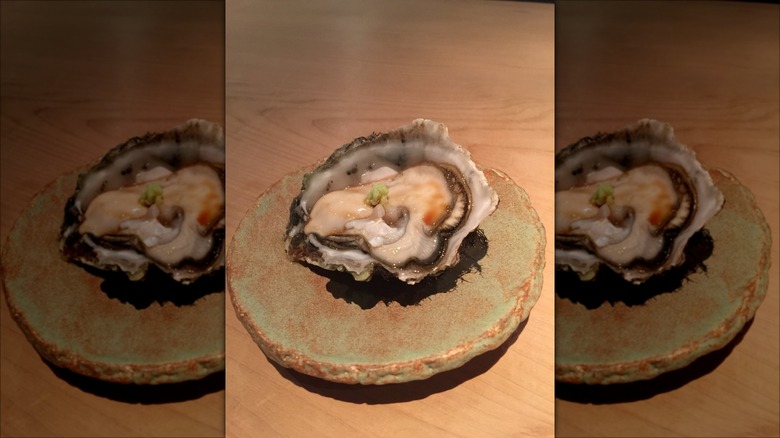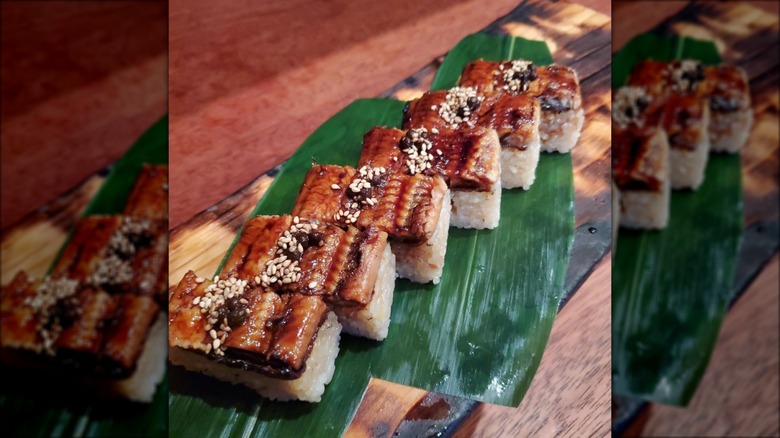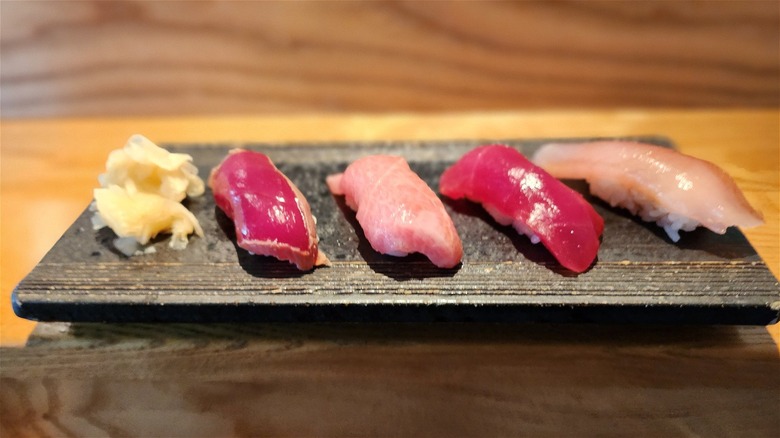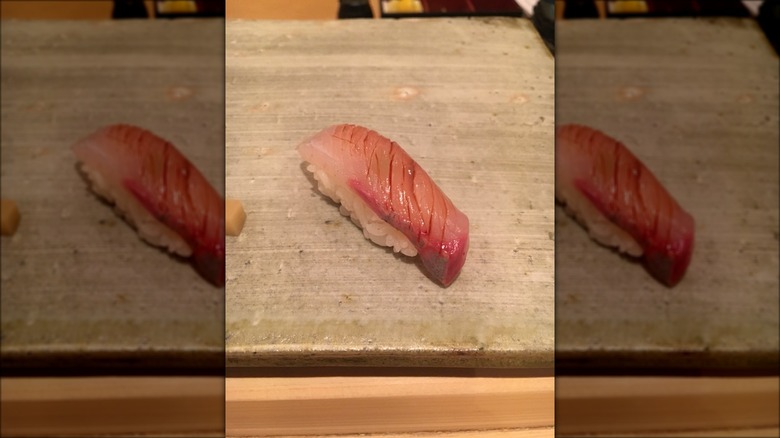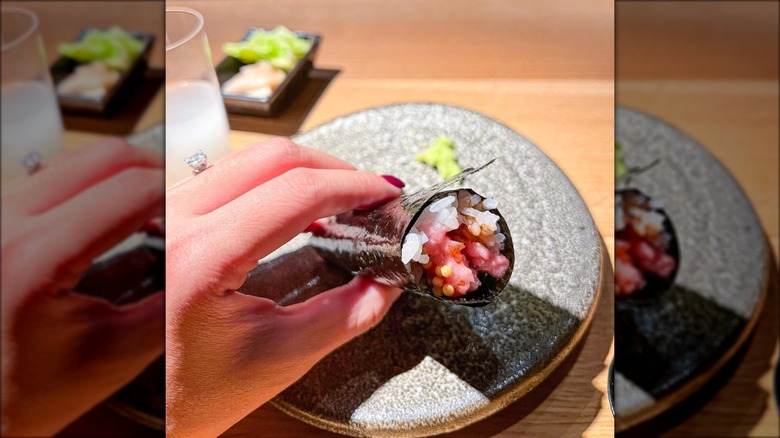The Best Sushi In America
Originating in China and perfected in Japan, sushi only found a major foothold in America after World War II. Despite its relatively short history, American sushi is amongst some of the best in the world. Here, traditional styles such as Edomae are served alongside extravagant, modern, and distinctly American takes on sushi.
Whatever the style, good sushi is defined by well-cooked and seasoned rice, a balance between flavors, and the use of impeccable, fresh fish. Once upon a time, these criteria were routinely met in sushi restaurants across America. However, the country's increased appetite for the dish has seen restaurants opening at a frantic rate. Not all of these establishments are staffed by adequately trained professionals; it has been reported that some sushi chefs are entering the American job market after completing courses that only last a matter of weeks. This is in direct contrast to the years-long apprenticeship that traditionally formed a sushi chef's training. An abundance of mediocre American sushi restaurants is the predictable result.
Thankfully, there are still many traditionally trained sushi masters working in the U.S. These chefs head small, understated restaurants from San Francisco to New York, practicing the craft they have dedicated their lives to. It is in these establishments that you will find the best sushi in America.
1. Hayakawa (Atlanta, Georgia)
There are only eight seats available at Hayakawa, each located at the sushi counter. As a result, every guest is treated to an unobstructed view of sushi master Atsushi Hayakawa as he expertly crafts what is undoubtedly some of the best sushi in America.
Hayakawa began his training at 15 years old and a lifetime of practice is evident in each of the 16 courses served on the restaurant's omakase menu. Several excellent appetizers set the tone, but it is nigiri that dominates the experience. For the nigiri, Hayakawa slices the world-class fish thick in a rare and decadent style that fully demonstrates the flavor.
At $315 per seating, Hayakawa's omakase experience is by no means cheap. It is, however, an unforgettable dining experience that more than justifies the price.
2. Uchi (Austin, Texas)
Uchi opened in Austin in 2003 and promptly transformed the city's entire culinary reputation. This was thanks to the restaurant's extremely inventive take on sushi, which also earned owner and chef Tyson Cole a James Beard award in 2011. More impressive than even this accolade is that 20 years on, Uchi is still leading Austin's culinary scene.
As with all sushi restaurants on this list, a large part of Uchi's appeal is found in the quality of its fish. No restaurant has a better supply; all fish is directly imported from Japan's famed Toyosu market. Upon arrival, the fish is expertly prepared by head sushi chef Shannon Kennedy. Guests can expect classic cuts of eel, yellowtail, and amberjack to feature on the a la carte menu, although we would suggest you trust Chef Kennedy and order the omakase. Faith in her ability is never misplaced.
3. Masa (New York City, New York)
As the only three Michelin starred sushi restaurant in the United States, visiting Masa is at the top of every American sushi lover's bucket list. The restaurant is helmed by Masayoshi Takayama, a chef who has dominated the American sushi scene for decades. He's even been featured on a variety of TV programs including "Parts Unknown."
While Takayama's stardom might draw some customers to Masa, most visit to experience the chef's unrivaled mastery of sushi firsthand. The omakase menu changes daily, but all guests are treated to astounding creations such as Takayama's signature dish of minced toro and Ossetra caviar.
Masa is home to a superstar chef who is at the peak of his powers. The bill reflects this; omakase at the restaurant starts at $750. Those wishing to sit at the Hinoki counter must part with over $1,000.
4. Akikos (San Francisco, California)
Akikos is a well-established sushi restaurant that, despite being opened in 1987, still manages to surprise its guests. This is largely due to owner Ray Lee's daring approach to hospitality. Under his ownership, Akikos became the first restaurant in San Francisco to serve an omakase menu. Today, it is known for serving high-quality fish sourced from Japan's Toyosu market alongside humble local varieties that have been painstakingly dry-cured.
Dishes are prepared by head sushi chef Shinsuke Hayashi and include aged, soy-cured bluefin tuna nigiri. Another standout is grilled shokupan topped with toro and golden Kaluga caviar. Many of the dishes appear before the customer complete with lavish presentations; the icing on what is already a rather large cake.
5. Sushi Nakazawa (New York City, New York)
People all over the world fell in love with sushi after watching David Gelb's 2011 documentary "Jiro Dreams of Sushi." While focusing on eminent sushi master Jiro Ono, several other chefs and apprentices are featured in the documentary, including a young Daisuke Nakazawa.
During the 11 years he spent under Ono's tutelage, Nakazawa developed skills to rival any sushi chef in the world. He puts these skills to good use at Sushi Nakazawa in New York's West Village, turning out a 20-course omakase menu that spotlights a traditional selection of fish. These dishes are imbued with an understated flair as typified by hay-smoked yellowtail and a scallop flavored with yuzu kosho. Most impressively, Nakazawa continues to offer this menu at an affordable price; the omakase costs between $120 and $150, considerably cheaper than other sushi restaurants in New York.
6. Cafe Sushi (Boston, Massachusetts)
Before the Coronavirus pandemic, Cafe Sushi was a bustling restaurant that was slinging some of the best sushi in Boston. During lockdown, the restaurant pivoted to takeout and the switch has stuck. Today, Cafe Sushi only serves takeout and delivery as well as grab and go. A small sake shop completes the establishment.
While many things about Cafe Sushi have changed, the important things have not. It still serves the celebrated ikura sushi and the classic yellowtail nigiri remains as good as ever. New and exclusive to the takeout menu are several platters, combination boxes, and bento boxes. These are perfectly designed for home delivery and cater to a variety of tastes and party sizes. All of this leads us to a startling conclusion: The best sushi in Boston can only be enjoyed at home.
7. Yui Edomae Sushi (Las Vegas, Nevada)
Sushi master Gen Mizoguchi is a rare talent who specializes in Edomae-style sushi. Treated fish, either cooked or cured, forms the basis of this sushi style, giving Mizoguchi further opportunities to create as much flavor as possible. He makes the most of it, employing a wide range of various curing and aging techniques. Even the meat can't escape with A5 wagyu being pressed between Himalayan salt blocks before being served at Yui Edomade Sushi
Mizoguchi is renowned for only using the very best fish; 80% of the restaurant's stock comes from Japan's Tsukiji and Fukuoka markets. Tuna, perch and mackerel all get their moment to shine but it is the rarer offerings, like tiny river crabs designed to be eaten whole, that really stand out.
8. Sushi Taro (Washington, D.C.)
Unfortunately, the term omakase is used liberally in America as Sushi Taro's co-owner Jin Yamazaki explained to Thrillist: "Many restaurants say that they do omakase. But they're just doing a tasting menu. It's a series of courses that are already set." Yamazaki and Sushi Taro's chef Masa Kitayama take great pride that their restaurant is one of few that embodies the true nature of omakase with each guest's experience being customized to match palate and preferences.
The two highlights of Sushi Taro's omakase experience are the sashimi course and the nigiri course. Both start with the customer and chef discussing the different fish types that are available that day before a selection is made. Whatever decision is reached, guests at Sushi Taro can expect to enjoy high-quality seafood from both Japan and America.
9. Sushi Yoshizumi (San Mateo, California)
Sushi Yoshizumi specializes in classic interpretations of Edomae-style sushi. Unlike other sushi restaurants, there is little in the way of over-stuffed maki rolls or blowtorched A5 wagyu. Instead, chef Akira Yoshizumi presides over a procession of finely crafted sushi that encompasses seafood like sea urchin and smelt.
Yoshizumi trained under sushi master Takumi Okabe, a chef with over 45 years of experience making Edomae sushi. It is clear that Yoshizumi made the most of this apprenticeship; Sushi Yoshizumi is consistently lauded by critics including Soleil Ho and has held one Michelin star since 2016.
10. Royal Sushi & Izakaya (Philadelphia, Pennsylvania)
As the name suggests, Royal Sushi & Izakaya is a restaurant of two parts: a raucous izakaya out front and a quiet, eight-seat sushi bar in the back. A la carte sushi is available in both, including options like California rolls, dragon rolls, and salmon avocado rolls.
While all the sushi is excellent, the best move is to snag a seat at the sushi bar and order the 17-course omakase menu. Owner Jesse Ito, the man behind the sushi counter, has 18 years of experience to draw on. The best testament to his skill is the fact that 75% of all Royal Sushi guests are returners. You don't endure that degree of loyalty without producing some exceptional sushi.
11. Nodoguro (Portland, Oregon)
Nodoguro has known many homes in Portland including various pop-up sites and the current location down an alleyway. All these spots have borne witness to chef Ryan Roadhouse's take on Kappo cuisine. His style encompasses a variety of dishes including sea urchin risotto and sesame tofu. While all dishes served are excellent, sushi is the real highlight. This should come as no surprise given that Roadhouse headed one of Denver's premier sushi restaurants at the tender age of 25.
As with all great sushi, it is not only the fish that inspires at Nodoguro but the rice too. This was highlighted in one review left on Yelp: "Nodoguro is the first place she [reviewer's wife] understood why there's such a heavy emphasis on rice in sushi [...] the rice there is so sublime that it creates a new category of what rice can be."
12. Omakase (San Francisco, California)
Omakase is another brilliant sushi restaurant located in San Francisco. It is headed by Jackson Yu, an Edomae sushi expert who uses traditional techniques like sujime – a marinating technique — and curing with kombu to craft intensely flavorful dishes.
Sea bream nigiri and monkfish liver prove exceptional on the palate but what really sets Omakase apart is the restaurant's laid-back atmosphere. This is a welcome respite from the hushed, frigid atmosphere found in other high-end sushi restaurants. While the staff play their part in fostering a relaxed atmosphere, the extensive sake menu — and pairing option – undoubtedly helps. After all, who can fail to smile when served some of the best sushi and sake America has to offer?
13. Shuko (New York City, New York)
Shuko is a sushi bar in downtown New York that does not play by the rules. Instead of a hallowed environment and hushed atmosphere, rap music pumps from the speakers and chefs wearing baseball caps work behind the counter. The food produced is equally refreshing and includes a take on a spicy tuna roll that's laden with pickled Thai chilies.
While Shuko only serves tasting menus, there are occasionally some off-menu items that can be added. The most celebrated of these is a monstrous bluefin tuna collar served with seaweed and rice. Other supplemental options include grilled shokupan with toro, sea urchin, and caviar. Purists will complain it's not traditional sushi. Those in the know will be too busy enjoying themselves to respond.
14. Matsumoto (Los Angeles, California)
A strip mall off Beverly Boulevard is not the first place you'd expect to find some of America's best sushi. But this has not stopped chef Naruki Matsumoto whose eponymous restaurant has been at the forefront on Los Angeles' sushi scene since opening in 2016.
Both a la carte and omakase menus are available at the restaurant. The former boasts an extensive array of options with classics like toro nigiri rubbing soldiers with inventive options such as octopus with citrus, sea salt, and yuzu kosho.
Omakase at Matsumoto is split into two different options with 15 or 25 pieces of nigiri offered respectively. In contrast to other sushi restaurants on this list, Matsumoto's omakase does not rely on cute or clever dishes before and after the nigiri. Instead, the focus remains on the sushi throughout much to the benefit of all guests.
15. Taneda Sushi In Kaiseki (Seattle, Washington)
Taneda Sushi nine-seat restaurant is the brainchild of Japanese chef Hideaki Taneda who painstakingly recreated a classical Japanese sushi bar in Seattle's Capitol Hill. Taneda's attention to detail is not limited to architecture alone; every morsel of food at his restaurant is carefully considered before serving. For example, Taneda blends his own soy sauce using dealcoholized sake and mirin. Snowmelt is used for cooking the rice and three types of vinegar are used to season it.
For $180 customers can enjoy 25 courses prepared and served by Taneda himself. Although the menu is ever-changing, one dish all customers are guaranteed is Taneda's signature hand roll of toro stuffed with pickled daikon. A selection of nigiri and kaiseki plates is also a given.
16. Yoshino (New York City, New York)
Yoshino is the only sushi restaurant in New York to have a four-star rating from The New York Times. Such honors are commonplace for chef Tadashi Yoshida who also boasts a Michelin star and an incredibly successful — now shuttered — Japanese restaurant to his name. So good is the restaurant, however, that you'll wonder if one Michelin star is not a tad harsh.
The dining experience at Yoshino begins with gentle appetizers and is finished with format-defying desserts. However, the vast majority of the meal belongs to traditional nigiri. This allows Yoshida the time and space to craft a variety of mind-boggling iterations. The highlight of these is cured mackerel that's kissed by flaming hot coals and served in nori.
It must be said that a meal at Yoshino is prohibitively expensive. But then again, excellence always is.
17. Kyoten Next Door (Chicago Illinois)
Kyoten is an exceptional sushi restaurant located in Chicago's Logan Square. Fantastic reviews abound, the only drawback is the cost — a meal begins at $440. Thankfully, chef Otto Phan is aware that not all sushi lovers can afford to spend this amount of money on a single meal. For those people, Phan opened Kyoten Next Door, a more relaxed and affordable take on the Kyoten ethos that still serves incredible sushi.
A 15-course meal at Kyoten Next Door is around $300 less than dinner at the adjoining Kyoten yet the standard is just as high. The fish is still sourced from Japan as is a rare type of rice known as Inochi no Ichi. When combined, these ingredients are a force to be reckoned with; the pull of them may lure you into the restaurant time and again.
18. Sushi Takeda (Los Angeles, California)
Chef Hide Takeda is an immensely respected figure in Los Angeles' sushi scene, having worked at several of the city's best restaurants including Sushi Tsujita. At Sushi Takeda, this esteemed chef employs a range of aging and curing processes to develop the flavor of fish prior to serving. While intricate, these processes are not lost on the diners as the resulting fish is noticeably firm and intensely flavorful.
As well as classics like bluefin tuna, Takeda serves up other more interesting options including a dish of white squid with fermented tuna intestine. That being said, all dishes pale in comparison to Takeda's house signature, a sardine roll filled with ginger and shiso and wrapped in pickled daikon; it's a piece of sushi that lives long in the memory.
19. Kata Robata (Houston, Texas)
Kata Robata is one of Houston's most versatile restaurants. It is simultaneously a sushi bar, clamorous izakaya, and deft omakase serving establishment. Stradling so many subcategories would cause many chefs to cut corners. Thankfully, Manabu Horiuchi is not one of them. This four-time James Beard Award nominee has built a kitchen team that is capable of pleasing three distinct audiences. The key? An array of exceptional food.
Seafood takes center stage at Kata Robata and is flown in from Japan multiple times a week. Regular sushi options include Japanese sardines and sea bass with nori puree. More cutting-edge options, such as octopus crudo with enoki mushrooms, prove an exceptional accompaniment.
20. Shion 69 Leonard Street (New York City, New York)
Shion 69 Leonard Street is one of the best sushi restaurants in New York City and consequently, the entire United States. The man behind the counter is none other than Shion Uino an industry legend who worked for years under the tutelage of Takashi Saito at Sushi Saito, an iconic Tokyo restaurant that previously held three Michelin stars.
In his eight-seat restaurant, Uino crafts exquisite sushi and sashimi in a traditional and modest manner. The flavors, however, are anything but understated with each ingredient being amplified to incredible levels. The seafood's immense flavor is partly thanks to Uino's sourcing process. Nearly all his fish are killed using a method that delays the rigor mortis process, leaving the fish fresher for longer. Uino's immense talent does the rest.
21. Naoe (Miami, Florida)
There have been some small restaurants featured on this list but none are as intimate as Naoe which, with five seats, only boasts two more customers than staff. Of course, this gives all who dine here an exceptional degree of attention from chef Kevin Cory. This is more than welcomed; Naoe's menu changes daily and regularly encompasses seafood that is not seen in other Miami restaurants. Information is readily given and eagerly received.
One of the reasons Naoe's menu changes so regularly is the team's commitment to seasonality, another is the restaurant's commitment to never serving a customer the same dish twice. Whatever the time of year, a meal at Naoe starts with a bento box. This is followed by around nine courses of nigiri including eel, sea urchin, and a variety of fish all topped with chef Cory's own soy sauce.
22. Ken (San Francisco, California)
Despite opening during the Coronavirus pandemic, Ken has gone from strength to strength, carving a place for itself among San Francisco's illustrious range of sushi restaurants. This is largely due to chef Ken Ngai's ability to create interesting and new flavor combinations. The chef particularly relies on leftfield sushi toppings like preserved plums to add nuanced complexity to his sushi.
Vitally, Ngai does not let his creativity take him too far. Every dish featured in the 14-course omakase menu places seafood front and center. Flavors never clash no matter how ill-matched they initially seem. Add to these unique flavors a jovial atmosphere and it is not difficult to see why Ken has emerged from the pandemic as one of San Francisco's most respected sushi bars.
23. Sushi Kashiba (Seattle, Washington)
Sushi Kashiba is the latest restaurant to be headed by Shiro Kashiba, a man who has spent 50 years serving the Emerald City. Before he settled in Seattle, Kashiba learned his craft under Jiro Ono and at Sushi Kashiba, this shows. The legendary chef uses all his experience to produce a diverse range of menus and a la carte options that suit multiple budgets and tastes.
Kashiba's best offerings are to be found at the counter, which only accepts customers on a first come first serve basis. Here, guests will enjoy the likes of albacore belly, mackerel, and squid, the vast majority served as nigiri.
24. Kabuto Edomae Sushi (Las Vegas, Nevada)
In a place like Las Vegas, it is hard for any restaurant to stand out from the crowd. Kabuto Edomae Sushi does, and without resorting to the garish lights or obnoxious gold-leaf-topped dishes employed by many other restaurants in the city. Instead, Kabuto Edomae Sushi stands out because of the expertly executed sushi it serves week in and week out. Sashimi and nigiri both feature in the restaurant's two omakase menus.
The chef's showmanship is of equal quality to the food. This was highlighted by one reviewer on TripAdvisor: "It is hard to describe the feeling you get when the chef expertly prepares each piece of nigiri right in front of you, personally puts it on your plate and waits to see your reaction when you eat it. How rare is it to have one perfect bite after another for an entire meal?"
25. Hiroki (Philadelphia, Pennsylvania)
As is the case with many restaurants on this list, Hiroki comes from a chef who cut his teeth under the tutelage of a legend. In this instance, Hiroki Fujiyama trained under Masaharu Morimoto for over a decade. Despite this long duration, Fujiyama has managed to develop a decadent style of his own. This is on show at Hiroki where an appetizer of quail egg may lead to a slither of A5 wagyu steak.
Don't worry, Fujiyama does not overlook the sushi. All told, the 20-course omakase menu includes around 12 pieces of nigiri, including sea urchin, barracuda, and mackerel. All staff adopt a practice known as omotenashi wherein guests have their every need catered for. Such pampering is rare, even in the world's most exclusive restaurants.
